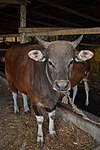| Bali cattle | |
|---|---|

| |
| Conservation status | |
| Domesticated | |
| Scientific classification | |
| Domain: | Eukaryota |
| Kingdom: | Animalia |
| Phylum: | Chordata |
| Class: | Mammalia |
| Order: | Artiodactyla |
| Family: | Bovidae |
| Subfamily: | Bovinae |
| Genus: | Bos |
| Species: | B. domesticus |
| Binomial name | |
| Bos domesticus Wilckens, 1905 | |
| Synonyms | |
| |
The Bali cattle (Bos domesticus), also known as Balinese cattle, Bali banteng, Indonesian cattle, or most generally, the domestic banteng are a domesticated species of bovine which originated from the banteng (Bos javanicus). Bali cattle are an important source of meat and are used for plowing. They are thought to have originated in Bali.
History and range
The Bali cattle are one of the few species of true cattle that did not descend from the extinct aurochs. Their domestication occurred around 3500 BC, originating from banteng.
Bali cattle have been introduced to East Timor, Java, Malaysia and Australia as livestock, and account for about one fourth of the total cattle population of Indonesia. In eastern islands, they account for up to four-fifths of the cattle. In the Northern Territory of Australia, they have escaped from captivity and roam in large herds damaging crops.
Characteristics
Bali cattle have a hump, a white rump patch, white stockings, and white extending under the belly. Females are reddish-yellow, and males are reddish brown, turning to a dark brown with maturity. Compared to banteng, Bali cattle are smaller, demonstrate less obvious sexual dimorphism, have smaller horns, and have less developed withers. Body weights of males average from 335 to 363 kilograms, while females average from 211 kilograms to 242 kilograms.
Bali cattle are noted for their remarkable ability to grow on low-quality fodder and their high fertility.
Husbandry
The temperament of the Bali cattle is timid and deer-like, making them suitable for plowing rice paddy fields, but their hooves are too soft to pull cargo on paved roads. Mechanization and urbanization are making the cattle redundant as draft animals, however.
Meat from young Bali cattle is noted for being exceptionally tender.


Problems with the livestock include small birth and weaning weights, high calf mortality rates, slow growth rates, and low milk production.
Breeding
Artificial insemination was first introduced to Bali cattle in southern Sulawesi and Timor in 1975 and 1976. It has been performed in Bali since the 1980s with semen from the National Artificial Insemination Centre of Singosari, and semen has been produced and distributed by the Artificial Insemination Centre of the Bali Province since 2001.
Disease
Domestic banteng are noted for their high resistance to most diseases. However, they are susceptible to malignant catarrhal. The cattle are also very susceptible to Jembrana disease, which was first described in the cattle in 1964.
Conservation
The population of Bali cattle has been declining in most places, due to greater consumption of the cattle than local capacity to supply. In recent years, there have been calls to increase the population of domestic banteng. Ronny Rachman Noor from Bogor Agricultural Institute has charged that the Indonesian government has undervalued the cattle simply because they were local, and that national policies must be enacted to optimally preserve the cattle.
The Indonesian government has understood the need to explore new strategies to improve the low productivity of Bali banteng and address concerns relating to husbandry and nutrition, but this adoption has been historically slow.
References
- Menkhorst, Peter (18 March 2011). A Field Guide to the Mammals of Australia. Oxford University Press. ISBN 9780195573954.
- Porter, Valerie (15 February 2008). The Field Guide to Cattle. Voyageur Press. ISBN 9781616739522.
- ^ Mohamad, Kusdiantoro; Olsson, Mia; van Tol, Helena T. A.; Mikko, Sofia; Vlamings, Bart H.; Andersson, Göran; Rodríguez-Martínez, Heriberto; Purwantara, Bambang; Paling, Robert W. (13 May 2009). "On the Origin of Indonesian Cattle". PLOS ONE. 4 (5): e5490. Bibcode:2009PLoSO...4.5490M. doi:10.1371/journal.pone.0005490. ISSN 1932-6203. PMC 2677627. PMID 19436739.
- ^ Lisson, Shaun; MacLeod, Neil; McDonald, Cam; Corfield, Jeff; Pengelly, Bruce; Wirajaswadi, Lalu; Rahman, Rahmat; Bahar, Syamsu; Padjung, Rusnadi (1 September 2010). "A participatory, farming systems approach to improving Bali cattle production in the smallholder crop–livestock systems of Eastern Indonesia". Agricultural Systems. 103 (7): 486–497. doi:10.1016/j.agsy.2010.05.002. ISSN 0308-521X.
- ^ Porter, Valerie; Alderson, Lawrence; Hall, Stephen J. G.; Sponenberg, D. Phillip (9 March 2016). Mason's World Encyclopedia of Livestock Breeds and Breeding, 2 Volume Pack. CABI. ISBN 9781845934668.
- ^ "Bali cattle". My Daily Cow. Kranky Kids. 2009. Archived from the original on 15 March 2019. Retrieved 5 June 2019.
- Herring, Andy D. (24 October 2014). Beef Cattle Production Systems. CABI. ISBN 9781780645070.
- Ainsworth, Ross (3 June 2015). "Four beautiful Bali cows, destined for an uncertain future". Beef Central. Archived from the original on 5 June 2019. Retrieved 5 June 2019.
- ^ Mohamad, K.; Colenbrander, B.; Purwantara, B. (2008). "Reproductive performance of Bali cattle following artificial insemination in Bali". Reproductive Biotechnology for Improved Animal Breeding in Southeast Asia: 54–59. Archived from the original on 5 June 2019. Retrieved 5 June 2019 – via IPB Repository.
- Desport, Moira (2010). Lentiviruses and Macrophages: Molecular and Cellular Interactions. Horizon Scientific Press. ISBN 9781904455608.
- Sufa, Theresia (19 April 2018). "Bali cattle national asset that needs to be preserved". The Jakarta Post. Archived from the original on 5 June 2019. Retrieved 5 June 2019.
| Taxon identifiers | |
|---|---|
| Bos javanicus domesticus | |